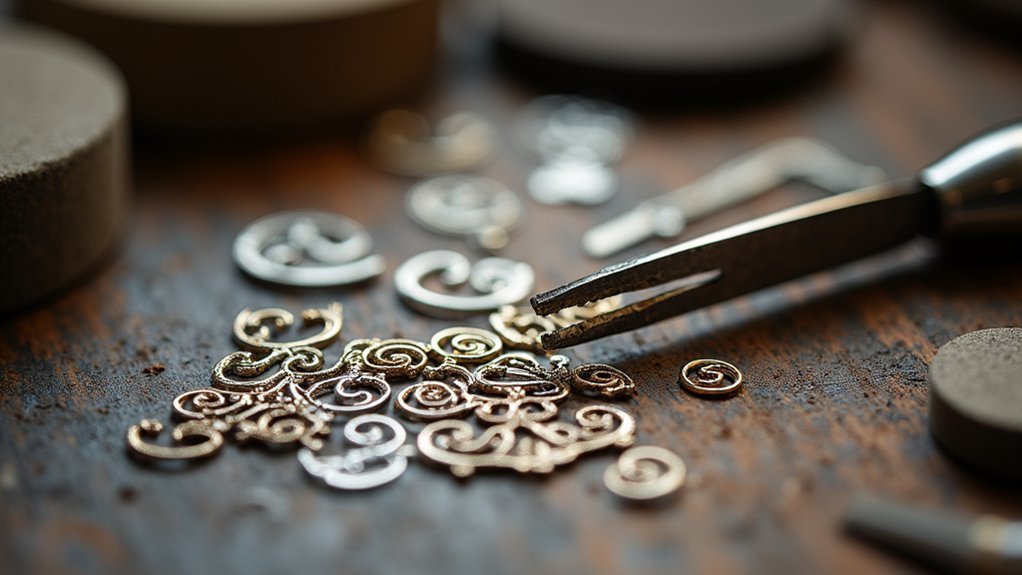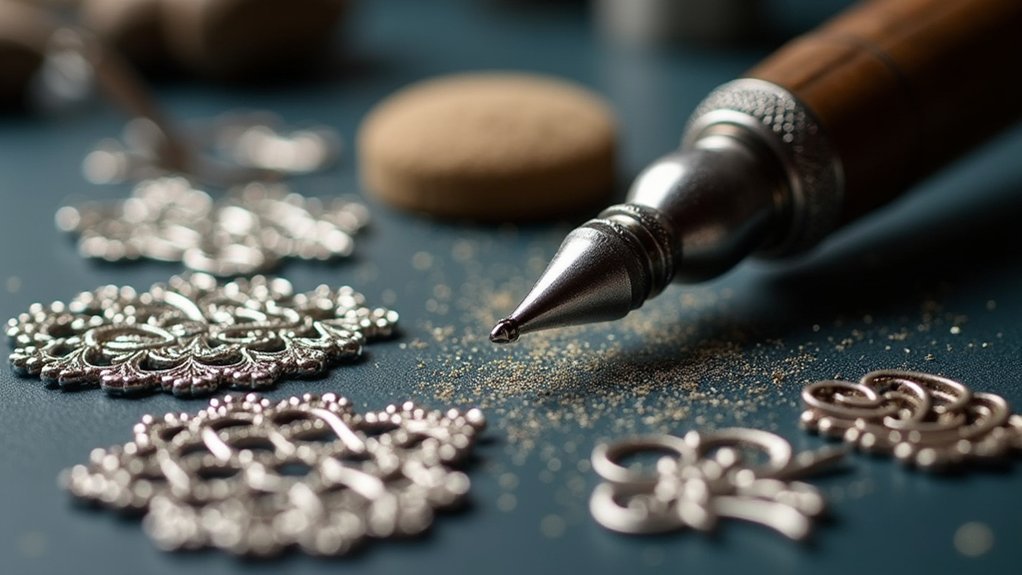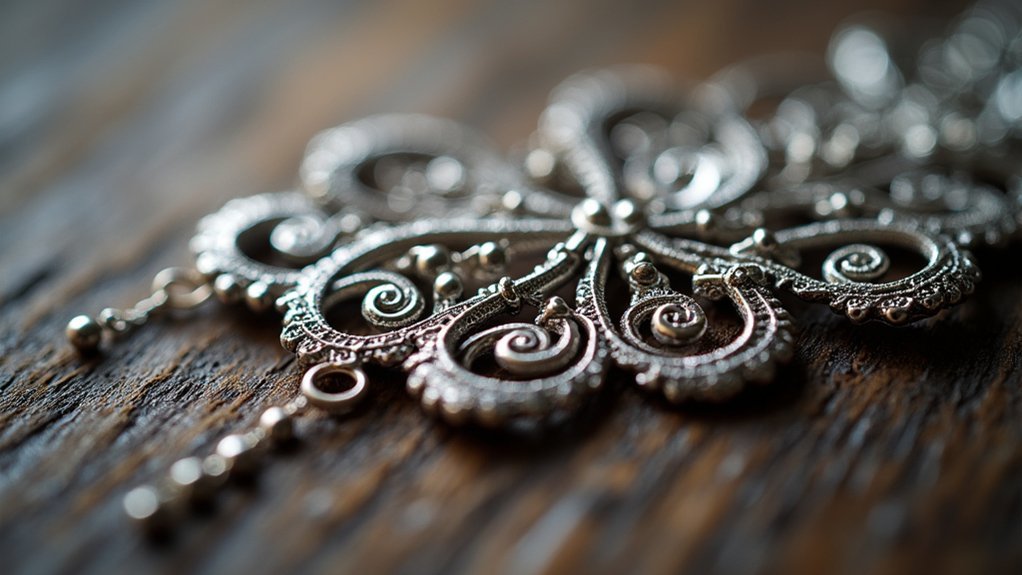You’ll need a flex shaft with blue radial disks for pre-polishing and chamois buff with Zam compound for the final mirror finish. Start by cleaning your filigree piece in hot pickle for two minutes, then use a soft-bristle brass wire brush to brighten intricate areas without damaging delicate wirework. Apply selective polishing techniques based on your wire type—smooth wire needs silicon wheels while twisted wire requires traditional methods. Master these fundamentals and you’ll discover advanced professional secrets.
Essential Tools and Equipment for Filigree Polishing

Precision matters when polishing filigree’s intricate wirework, and you’ll need specialized tools that won’t damage these delicate designs. A flex shaft or buffer is essential for efficient polishing without risking harm to your filigree jewellery.
You’ll want three blue radial disks for pre-polishing to prepare surfaces before achieving that high shine with a chamois buff and Zam compound.
Don’t overlook cleaning tools – a soft-bristle toothbrush gently removes dirt buildup from intricate areas without bending delicate wires.
For traditional finishes, silicon wheels work perfectly for cleaning smooth wire sections, while brush finishing cleans between wires before high polishing.
These specialized tools guarantee you’ll maintain your filigree pieces’ original brilliance while greatly enhancing their longevity through proper maintenance.
Pre-Polishing Preparation and Cleaning Steps
Before you can achieve that stunning mirror finish, proper preparation sets the foundation for successful filigree polishing. Start by thoroughly cleaning your filigree piece with mild soap and water, removing all dirt and oils that could interfere with the polishing process.
After soldering, soak the jewelry in hot pickle for two minutes to eliminate flux and oxidation. Follow this with a rinse using mild liquid detergent and gentle brushing with a brass wire brush for brightening.
For intricate designs, use a soft-bristle toothbrush to carefully remove dirt buildup without damaging delicate wires.
Remember proper care includes removing dried polish and grime beforehand—this step alone might restore luster.
When cleaning silver filigree, use a tumbler before stone setting for even finishes, but never after stones are attached.
Flex Shaft and Buffer Techniques for Delicate Work

When working on intricate filigree pieces, your flex shaft becomes your most valuable tool for achieving professional results without destroying delicate wirework. You’ll maintain precise control while maneuvering tight spaces that standard rotary tools can’t reach effectively.
| Stage | Tool/Buffer | Compound |
|---|---|---|
| Pre-polish | 3 Blue Radial Disks | Tripoli |
| Pre-polish Alternative | Small Diameter Brush | Greystar |
| Final Polish | Chamois Buff | Zam |
Start with three blue radial disks for pre-polishing your silver filigree jewelry. They’ll prepare surfaces without damaging fine details. Alternatively, use small diameter brushes with tripoli or greystar for intricate wire sections. For final finishing, attach a chamois buff with Zam compound—the chamois prevents snagging on delicate elements. Remember to regularly clean your flex shaft and buffers to maintain peak performance throughout your polishing process.
Radial Disk Applications for Initial Surface Treatment
Building on the foundation of proper flex shaft setup, radial disks serve as your primary weapon against surface imperfections that can mar your filigree’s final appearance. Start with medium to coarse grit radial disks to tackle rough areas while preserving your delicate design’s integrity.
You’ll achieve excellent results by using three blue radial disks in succession, progressing from coarsest to finest grades. This systematic approach greatly enhances surface quality before final polishing.
Maintain consistent speed and apply light pressure to prevent overheating that could damage your filigree structure. The rubber or abrasive material construction of these disks makes them ideal for pre-polishing work.
Don’t forget essential safety gear—wear eye protection and a dust mask to shield yourself from metal particles and debris during the surface treatment process.
Chamois Buff and Zam Polish for Mirror Finishes

Achieving that coveted mirror finish on your filigree requires the gentle touch of a chamois buff paired with Zam polish. This combination’s your secret weapon for creating stunning, high-gloss results without damaging delicate wirework.
The chamois buff’s soft texture prevents snagging on intricate designs while Zam polish delivers fine abrasive action for exceptional brightness. You’ll maintain complete control during application, greatly reducing over-polishing risks that could harm those precious details.
Mount your chamois buff on a flex shaft or buffer, keeping speeds low to prevent overheating. Apply Zam polish sparingly and work systematically across the surface. This controlled approach guarantees even coverage and prevents damage to your piece’s intricate elements.
Regular use of this technique preserves your filigree’s luster and structural integrity for years.
Tumbler Methods for Pre-Setting Filigree Pieces
You’ll achieve superior polishing results by using your tumbler before setting any stones in your filigree pieces.
The tumbling process allows thorough cleaning and polishing of the intricate metalwork without risking damage to delicate components or loosening stones.
However, you must consider proper timing and safety measures to protect your filigree’s structural integrity during the tumbling process.
Timing Before Stone Setting
Before you set any stones into your filigree work, tumbling offers a perfect opportunity to achieve a flawless polish that would be impossible once gemstones are in place.
You’ll want to complete all polishing before any stone setting begins, as the tumbler’s agitation can loosen or damage already-mounted gems.
Plan your filigree project timeline carefully. Complete all soldering, filing, and shaping first, then move to tumbling as your final polishing step.
This sequence guarantees you won’t need to handle stones during the tumbling process.
Check your tumbler’s manufacturer instructions for ideal timing settings specific to filigree pieces.
Most delicate filigree work requires shorter cycles than standard jewelry pieces.
Monitor the progress regularly to prevent over-polishing your intricate designs.
Tumbler Safety Considerations
While tumbling transforms your filigree into a professionally polished piece, several safety considerations demand your attention throughout the process.
Tumbler safety begins with proper media selection—choose gentle options that won’t damage your delicate filigree designs. Secure containment prevents pieces from catching or tangling during rotation.
You’ll face a significant cleanup challenge with scattered shot, so prepare your workspace accordingly.
Monitor tumbling duration carefully, as excessive processing destroys intricate details and compromises structural integrity. Your filigree’s delicate nature requires shorter cycles than standard jewelry pieces.
Always rinse thoroughly after tumbling to remove residual media and debris.
Pickling and Chemical Cleaning Processes

After completing your soldering work, you’ll need to remove the oxidation and flux residues that accumulate during the heating process. The pickling process involves soaking your filigree items in a hot pickle solution for approximately 2 minutes. This cleaning step effectively removes stubborn residues that can dull your delicate metalwork.
Hot pickle solution effectively dissolves oxidation and flux residues from soldered filigree, restoring clarity to your delicate metalwork in just two minutes.
Once pickled, boil your filigree pieces in mild liquid detergent to enhance their shine and prepare them for finishing.
After cleaning, use a brass wire brush to brighten all sides of your filigree, carefully preserving the intricate designs. For best results, perform a final boiling in lemon salt solution to restore the original luster.
Thorough cleaning prevents tarnishing and maintains your delicate metalwork’s integrity throughout the jewelry’s lifespan.
Wire Brush Brightening for Intricate Details
When tarnish and dirt settle deep within filigree’s intricate wirework, you’ll need a more targeted approach than general polishing methods can provide.
A soft-bristle brass wire brush becomes your precision tool for reaching between those delicate wires and restoring brightness to areas that cloths and compounds can’t access.
You’ll discover that proper wire brush technique transforms stubborn, darkened details back to their original lustrous appearance.
Brass Wire Brush Technique
One of the most effective methods for restoring brilliance to Polish filigree’s intricate details involves using a brass wire brush with careful precision. This technique helps you avoid scratching delicate metalwork while effectively brightening tarnished areas.
Always test your brass wire brush on a hidden section first to verify compatibility. Work in small sections using gentle pressure to prevent bending fine wires.
| Step | Action | Key Point |
|---|---|---|
| 1 | Test brush | Use hidden area first |
| 2 | Clean brush | Remove dirt buildup regularly |
| 3 | Apply gently | Work small sections only |
| 4 | Final polish | Use chamois buff with Zam |
Regular brush cleaning prevents dirt transfer that could damage your filigree. Complete the process with chamois buffing and Zam polish for maximum brilliance.
Cleaning Between Filigree Wires
Several intricate spaces between filigree wires demand specialized attention that standard cleaning methods can’t reach effectively.
You’ll need a soft-bristle wire brush with fine bristles that navigate tight spaces without scratching the metalwork. Select one that won’t bend or damage delicate structures during cleaning.
Gently brush between the wires, following the direction of the filigree pattern to maintain design integrity. This technique prevents dirt buildup that dulls finishes and obscures intricate details. Regular cleaning keeps your pieces looking pristine.
After brushing, rinse with clean water to remove loosened debris. Follow up with a soft cloth to wipe away remaining particles and restore the filigree’s natural shine.
This systematic approach guarantees thorough cleaning while preserving the jewelry’s delicate craftsmanship.
Selective Polishing Based on Filigree Types

Since each filigree style presents distinct challenges and opportunities, you’ll need to adapt your polishing approach to match the specific wire type and pattern you’re working with.
| Filigree Type | Primary Technique | Recommended Finish |
|---|---|---|
| Smooth Wire | Silicon wheels + brush finishing | High polish overall |
| Twisted Wire | Traditional methods | High polish frames, unpolished fillers |
| Milled Wire | Selective polishing | Contrasting finishes |
| Scrollwork | Blue radial disks + chamois buffs | Medium to high polish |
For smooth wire pieces, start with silicon wheels for cleaning, then brush between wires before final polishing. Twisted and milled styles benefit from creating contrast—polish frame wires to a high shine while leaving filler wires unpolished. When working with intricate designs, use flex shaft tools with blue radial disks and chamois buffs to prevent catching on delicate elements while achieving professional results.
Professional Maintenance and Long-Term Care Strategies
You’ll need professional expertise to maintain your filigree jewelry’s intricate beauty over time.
Schedule annual inspections with a specialized jeweler who can identify wear patterns and address issues before they become costly problems.
Consider applying protective coatings designed specifically for filigree work to prevent tarnishing and extend your pieces’ lifespan greatly.
Professional Cleaning Services
The intricate wirework of Polish filigree demands expertise that only professional cleaning services can provide.
These specialists use ultrasonic cleaning techniques that safely remove dirt and tarnish from delicate designs without causing damage to your valuable silver pieces. You can’t replicate these specialized methods at home, making professional services vital for proper maintenance.
Skilled jewelers can apply protective coatings that minimize future tarnish while preserving your jewelry’s original shine.
They’ll also inspect for loose or damaged wires during cleaning sessions, identifying potential problems before they worsen.
Never attempt DIY repairs on filigree pieces, as this often leads to further damage and decreased value.
Establishing annual cleaning appointments guarantees your Polish filigree maintains its beauty and extends its lifespan considerably.
Regular Inspection Schedule
While professional cleaning provides essential deep maintenance, implementing a consistent inspection routine at home protects your Polish filigree between service appointments.
You’ll want to examine your pieces every six months on a regular basis to catch potential issues early. Focus specifically on the delicate filigree wires, looking for any looseness, breaks, or signs of wear that need professional attention.
Document each inspection with detailed notes about dates and findings. This tracking system helps you monitor your jewelry’s condition over time and determines when maintenance becomes necessary.
During these regular checks, also review your storage setup to guarantee proper care. Verify humidity levels remain low and confirm you’re using individual compartments to prevent scratches and tarnishing between wears.
Protective Coating Applications
Several coating options can dramatically extend your Polish filigree jewelry’s lifespan by creating an invisible barrier against tarnish and oxidation.
Professional maintenance services offer specialized protective coating applications specifically designed for delicate antique silver pieces. These coatings preserve intricate filigree details without altering their appearance or damaging fine workmanship.
Choose protective coating products carefully to guarantee they’re safe for your valuable pieces. Professional jewelers can recommend appropriate options and apply them correctly.
Schedule regular inspections to determine when reapplication becomes necessary, as protective coating effectiveness diminishes over time.
Maximize coating performance by maintaining controlled storage conditions with low humidity levels. Keep your antique silver away from chemicals that could compromise the protective barrier.
This all-encompassing approach guarantees long-term preservation of your Polish filigree’s original luster and beauty.
Frequently Asked Questions
How Do You Polish Filigree?
You’ll pre-polish filigree using blue radial disks on a flex shaft, then finish with chamois buff and Zam compound. Use silicon wheels for cleaning smooth wires and brush finishing for intricate areas before final polishing.
Why Is Filigree so Expensive?
You’re paying for skilled artisans’ meticulous handwork, precious metals like gold and silver, and time-intensive craftsmanship. Each piece requires specialized techniques passed down through generations, making filigree rare and valuable.
What Are the Different Styles of Filigree?
You’ll find several distinct filigree styles including openwork with intricate cutouts, solid designs with minimal negative space, twisted wire for texture, bead incorporation, flowing scrollwork, geometric patterns, and regional variations from Indian, Italian, and Middle Eastern traditions.
Does Silver Filigree Tarnish?
Yes, your silver filigree will tarnish when exposed to moisture, sulfur, and air. Sterling silver tarnishes faster than fine silver due to copper content. You’ll notice darkening as silver sulfide forms on the surface over time.
In Summary
You’ve now mastered the essential techniques for polishing filigree like a professional. From selecting the right tools to applying specialized buffs and chemicals, you’re equipped to handle any intricate metalwork project. Remember that patience and practice are key—don’t rush through delicate areas. With consistent application of these methods, you’ll achieve stunning mirror finishes while preserving every intricate detail. Your filigree pieces will showcase the brilliant craftsmanship they deserve.





Leave a Reply